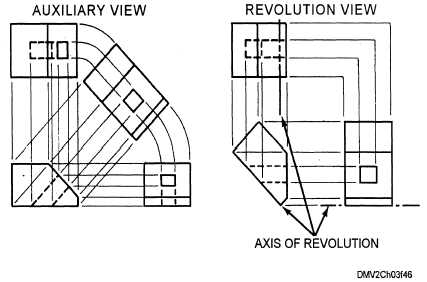Views, Continued
Revolutions
A revolution is a view of an inclined surface obtained by revolving the object
(not the observer as in auxiliary views) around an imaginary point until the
desired surface appears in true shape and size. The imaginary point is the
axis of revolution. Depending on the plane chosen, the axis is perpendicular
to the plane of projection. Begin drawing revolutions by showing the object
in its normal position, then revolving the object around the axis of revolution
until the inclined surface is parallel to the plane of projection. Draw the
plane of projection that is perpendicular to the axis first since it is the only
view that remains unchanged in size and shape. You may revolve the object
clockwise or counterclockwise. The first drawing of the revolved object is
called the primary revolution and each view drawn in a new position using
the primary revolution as a base is referred to as successive revohtions.
Three other important rules to remember when drawing revolutions: (1) the
revolved view always shows the axis as a point and this view does not change
in size and shape, (2) in views where the axis appears as a line, dimensions
parallel to the axis remains unchanged, and (3) lines that are parallel on the
object are parallel in any view.
Figure 3-46 is a comparison of an auxiliary and a revolution view.
Figure 3-46.—Comparing an auxiliary and revolution view.
Continued on next page
3-52

